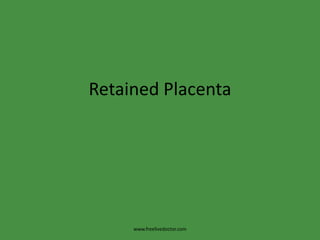
Retained placenta
- 2. Retained Placenta Definition:Failure of placental delivery within 30 minutes after delivery of the foetus. Incidence: 1%. www.freelivedoctor.com
- 3. Causes 1. Retained separated placenta due to: > Atony of the uterus: due to causes mentioned before. > Constriction ring. > Rupture uterus: where the placenta passes to the peritoneal cavity. www.freelivedoctor.com
- 4. Causes 2.Retained non-separated placenta due to: > Atony of the uterus. >Abnormal adherence of the placenta which may be: Simple adhesion: Manual separation can be done easily. Morbid adhesion:Placentaaccreta/Placenta accreta/Placenta percreta www.freelivedoctor.com
- 5. Clinical Picture Bleeding: occurs only if the placenta is separated partially or completely. Uterus: is lax in case of atony. Vaginal examination may reveal: >Constriction ring. > Rupture uterus. > Morbid placental adherence where there is no plane of cleavage. www.freelivedoctor.com
- 6. Management Uterine atony * Ergometrine and massage with gentle cord traction if failed do, * Brandt-Andrews manoeuvre if failed do, * Crédé’s method if failed do, * Manual separation of the placenta. www.freelivedoctor.com
- 7. Constriction ring Deep anaesthesia and amyl nitrite inhalation are given before manual separation of the placenta. www.freelivedoctor.com
- 8. Morbid adherence of the placenta * Simple adhesion and partial placenta accreta: Manual separation is usually successful. * Complete accreta: Hysterectomy is the treatment. If the patient is young and in need of more children, the umbilical cord is cut short and placenta is left in situ to undergo autolysis. The patient is given antibiotics to guard against infection and methotrexate to enhance the autolysis. www.freelivedoctor.com
- 9. In case of rupture uterus Manage as in rupture uterus. Crédé’s method: * The bladder is evacuated. * The uterus is massaged to induce contraction. * The fundus is grasped by 4 fingers behind and the thumb in front to squeeze the placenta. * The fundus is then pushed downwards and backwards to expel the placenta. www.freelivedoctor.com
- 10. Complications * Shock. * Inversion of the uterus. * Partial separation of the placenta causing postpartum haemorrhage. * Retained parts of the placenta or membranes. * Failure due to: > obesity, > non-co-operative patient, >placenta accreta > rigidity of the abdominal wall, or > constriction ring. www.freelivedoctor.com
- 11. Manual Removal of The Placenta * The procedure is done under general anaesthesia. * The right hand is introduced along the umbilical cord into the uterus. * The lower edge of the placenta is identified and by a sawing movement from side to side the placenta is separated from its bed. www.freelivedoctor.com
- 12. Manual Removal of The Placenta * Grasp the placenta and deliver it out. * Examine the placenta and membranes for completeness. * The left hand is supporting the uterus abdominally throughout the procedure. www.freelivedoctor.com
- 13. Complications * Perforation of the uterus. * Retained parts. * Infection. www.freelivedoctor.com
- 14. Complications of Retained Placenta * Shock. * Postpartum haemorrhage. * Puerperal sepsis. * Subinvolution. * Retained parts with subsequent haemorrhage, infection, placental polyp formation or choriocarcinoma. * Complications of the methods used for its separation. www.freelivedoctor.com